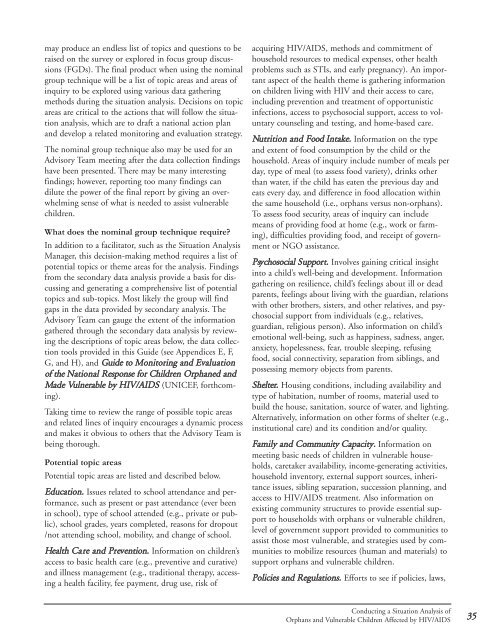Conducting a Participatory Situation Analysis of.pdf - Global HIV ...
Conducting a Participatory Situation Analysis of.pdf - Global HIV ...
Conducting a Participatory Situation Analysis of.pdf - Global HIV ...
Create successful ePaper yourself
Turn your PDF publications into a flip-book with our unique Google optimized e-Paper software.
may produce an endless list <strong>of</strong> topics and questions to be<br />
raised on the survey or explored in focus group discussions<br />
(FGDs). The final product when using the nominal<br />
group technique will be a list <strong>of</strong> topic areas and areas <strong>of</strong><br />
inquiry to be explored using various data gathering<br />
methods during the situation analysis. Decisions on topic<br />
areas are critical to the actions that will follow the situation<br />
analysis, which are to draft a national action plan<br />
and develop a related monitoring and evaluation strategy.<br />
The nominal group technique also may be used for an<br />
Advisory Team meeting after the data collection findings<br />
have been presented. There may be many interesting<br />
findings; however, reporting too many findings can<br />
dilute the power <strong>of</strong> the final report by giving an overwhelming<br />
sense <strong>of</strong> what is needed to assist vulnerable<br />
children.<br />
What does the nominal group technique require?<br />
In addition to a facilitator, such as the <strong>Situation</strong> <strong>Analysis</strong><br />
Manager, this decision-making method requires a list <strong>of</strong><br />
potential topics or theme areas for the analysis. Findings<br />
from the secondary data analysis provide a basis for discussing<br />
and generating a comprehensive list <strong>of</strong> potential<br />
topics and sub-topics. Most likely the group will find<br />
gaps in the data provided by secondary analysis. The<br />
Advisory Team can gauge the extent <strong>of</strong> the information<br />
gathered through the secondary data analysis by reviewing<br />
the descriptions <strong>of</strong> topic areas below, the data collection<br />
tools provided in this Guide (see Appendices E, F,<br />
G, and H), and Guide to Monitoring and Evaluation<br />
<strong>of</strong> the National Response for Children Orphaned and<br />
Made Vulnerable by <strong>HIV</strong>/AIDS (UNICEF, forthcoming).<br />
Taking time to review the range <strong>of</strong> possible topic areas<br />
and related lines <strong>of</strong> inquiry encourages a dynamic process<br />
and makes it obvious to others that the Advisory Team is<br />
being thorough.<br />
Potential topic areas<br />
Potential topic areas are listed and described below.<br />
Education. Issues related to school attendance and performance,<br />
such as present or past attendance (ever been<br />
in school), type <strong>of</strong> school attended (e.g., private or public),<br />
school grades, years completed, reasons for dropout<br />
/not attending school, mobility, and change <strong>of</strong> school.<br />
Health Care and Prevention. Information on children’s<br />
access to basic health care (e.g., preventive and curative)<br />
and illness management (e.g., traditional therapy, accessing<br />
a health facility, fee payment, drug use, risk <strong>of</strong><br />
acquiring <strong>HIV</strong>/AIDS, methods and commitment <strong>of</strong><br />
household resources to medical expenses, other health<br />
problems such as STIs, and early pregnancy). An important<br />
aspect <strong>of</strong> the health theme is gathering information<br />
on children living with <strong>HIV</strong> and their access to care,<br />
including prevention and treatment <strong>of</strong> opportunistic<br />
infections, access to psychosocial support, access to voluntary<br />
counseling and testing, and home-based care.<br />
Nutrition and Food Intake. Information on the type<br />
and extent <strong>of</strong> food consumption by the child or the<br />
household. Areas <strong>of</strong> inquiry include number <strong>of</strong> meals per<br />
day, type <strong>of</strong> meal (to assess food variety), drinks other<br />
than water, if the child has eaten the previous day and<br />
eats every day, and difference in food allocation within<br />
the same household (i.e., orphans versus non-orphans).<br />
To assess food security, areas <strong>of</strong> inquiry can include<br />
means <strong>of</strong> providing food at home (e.g., work or farming),<br />
difficulties providing food, and receipt <strong>of</strong> government<br />
or NGO assistance.<br />
Psychosocial Support. Involves gaining critical insight<br />
into a child’s well-being and development. Information<br />
gathering on resilience, child’s feelings about ill or dead<br />
parents, feelings about living with the guardian, relations<br />
with other brothers, sisters, and other relatives, and psychosocial<br />
support from individuals (e.g., relatives,<br />
guardian, religious person). Also information on child’s<br />
emotional well-being, such as happiness, sadness, anger,<br />
anxiety, hopelessness, fear, trouble sleeping, refusing<br />
food, social connectivity, separation from siblings, and<br />
possessing memory objects from parents.<br />
Shelter. Housing conditions, including availability and<br />
type <strong>of</strong> habitation, number <strong>of</strong> rooms, material used to<br />
build the house, sanitation, source <strong>of</strong> water, and lighting.<br />
Alternatively, information on other forms <strong>of</strong> shelter (e.g.,<br />
institutional care) and its condition and/or quality.<br />
Family and Community Capacity. Information on<br />
meeting basic needs <strong>of</strong> children in vulnerable households,<br />
caretaker availability, income-generating activities,<br />
household inventory, external support sources, inheritance<br />
issues, sibling separation, succession planning, and<br />
access to <strong>HIV</strong>/AIDS treatment. Also information on<br />
existing community structures to provide essential support<br />
to households with orphans or vulnerable children,<br />
level <strong>of</strong> government support provided to communities to<br />
assist those most vulnerable, and strategies used by communities<br />
to mobilize resources (human and materials) to<br />
support orphans and vulnerable children.<br />
Policies and Regulations. Efforts to see if policies, laws,<br />
<strong>Conducting</strong> a <strong>Situation</strong> <strong>Analysis</strong> <strong>of</strong><br />
Orphans and Vulnerable Children Affected by <strong>HIV</strong>/AIDS<br />
35















